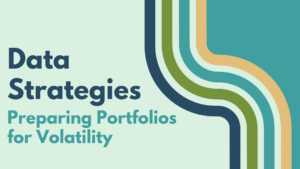- September and October are infamous for major bouts of volatility striking markets
- Amid a softening consumer landscape and uncertain Fed policy, industry experts will share their insights and what investors should look out for at the September 14 Data Minds event
- Our team also spotted unusual activity in the embattled Real Estate sector, but M&A action offers hope amid real estate’s ruins
It’s that time of year. The kids are back in school, the summer heat has given way to cool breezes, pumpkin spice is out in full force, and traders are on guard for volatility. Historically, the mid-September through October stretch is primetime for big stock swings, including some of the sharpest historical declines in global equities. Investors closely watch this period on the calendar, and, for traders, identifying the possible catalysts for volatility is the first step to staying ahead of it.
Data Minds: Preparing Portfolios for Volatility
Preservation of capital is often paramount this time of year versus portfolio appreciation. At the same time, though, some of the most bullish moves happen over the final two months of the year, so successfully venturing through the tail end of Q3 and the start of Q4 commonly requires being more nimble than at other times.
On September 14, Wall Street Horizon hosts Data Minds: Proactive Data Strategies for Navigating Market Uncertainty. Join us as our expert panel shares insights and experiences, providing you with the knowledge and strategies you need to manage volatility.
A Humbling Year
2023 has fooled many investors. Take yourself back to December last year. Market participants were on edge as fears of a recession were front and center. Wall Street strategists were as bearish as ever, with the average sellside S&P 500 forecaster expecting a negative return for large-cap US equities. The pessimism made some sense given that interest rates had surged in 2022 – last year was indeed the worst annual return on record for the aggregate bond index. Inflation remained high, auguring further Fed rate hikes, while geopolitical jitters remained (geopolitical risk was ranked as the top concern from our May 4 event, too).
AI Mania Boosts Big Caps
Another risk was just under the surface, but it was a risk to the upside. Investors were simply caught offside and too bearish on mega-cap tech stocks. You see, a little open-sourced artificial intelligence platform was just beginning to gain legs. ChatGPT was released in November 2022, fueling a boom that few saw coming. Jump ahead to today, and anything AI-related seems to be the darling of investors’ eyes. Corporate events focused on AI are giddy with enthusiasm and suddenly chipmaker Nvidia (NVDA) is the world’s fifth-largest publicly traded company.
Is the VIX Too Low?
More broadly, the Nasdaq Composite is up more than 40% on the year. The concentration of gains has resulted in the S&P 500 rallying less than 20% while an equal-weighted version of the Russell 1000 index sports just a modest return. The strong gains through early September, focused on a handful of glamour stocks, along with a spike in options trading volume (and speculation) has some investors nervous that a volatility event could be on the horizon, akin to what was seen in 1987. Who knows if that will play out, but it all feels a bit too quiet, doesn’t it? The VIX is near its softest levels since January 2020 all while the Treasury market sees wild rate swings.
Yet while volatility expectations remain low, corporate uncertainty is increasing. The Wall Street Horizon proprietary Late Earnings Report Index (LERI) tracks earnings date changes among publicly traded companies which can often serve as clues about their financial health. The LERI has a baseline reading of 100, anything above that indicates companies are feeling uncertain about their current and short-term prospects. A LERI reading under 100 suggests companies feel they have a pretty good crystal ball for the near-term. For the Q2 2023 earnings season the LERI stood at 126, the highest reading in a year, and second highest since the COVID-19 pandemic, possibly indicating CEOs are feeling a bit uneasy about present economic conditions.
Rate Volatility Remains Elevated
The MOVE Index, a gauge of volatility across the Treasury curve, hasn’t budged from extreme levels above 100. Unease regarding how the Fed will cap off its rate-hike cycle casts an ominous shadow over the market. To its credit, the FOMC appears to have done a good job of piloting the economy from four-decade-high inflation and slow growth (see: mid-2022) to what appears to be accelerating growth and lower inflation. The current Core PCE rate of 4.24% and robust Q3 real GDP projections are reasons for hope of a goldilocks soft landing.
Stock-Bond Correlations Still High Amid a “Good News Is Bad News” Market
The risk is that bringing the rate of personal consumption and inflation closer to 2% will be a tough ask. The result is not just a “higher for longer” interest rate regime, but a “high for really long” reality. That may be bad news for stocks since loftier interest rates might mean lower company valuations. So, the age-old battle between economic growth and tighter monetary policy may wage on into Q4 and beyond. Be sure to hear expert views on whether inflation or the level of interest rates is the primary concern going forward.
Other topics on the docket include what surging options volume might portend for markets, opportunities and threats from the alt data market, and AI tool use cases.
Hope For the REITs?
We’ll leave you with this company-specific nugget that might have bigger implications. Our team of analysts identified unusual activity in Kimco Realty Corporation (KIM). As of September 2, the $12 billion market cap Retail REITs industry company within the Real Estate sector had yet to confirm its Q3 earnings date slated for October 26 BMO (it normally confirms on August 23). While this would normally be a red flag, perhaps indicating bearish news or firm-specific issues, Kimco is actually getting into the M&A game.
It announced intentions to acquire RPT Realty in a $2 billion all-stock deal in late August. Amid a consumer that could face headwinds via a slowing jobs market and student loan repayments starting back up, there’s a lot to unpack on this front. We will keep this one on our radar and look forward to hearing the panel’s thoughts on the state of the consumer in advance of the busiest spending season of all.
The Bottom Line
Sign up for our September 14 Data Minds event. Our expert guests will identify and detail market-moving catalysts ahead of the most historically volatile weeks for stocks. We’ll talk about macro conditions along with data-specific topics, focused on risk management for traders and investors.
—
Originally Posted September 6, 2023 – Data Strategies to Prepare Portfolios for Volatility
Disclosure: Interactive Brokers
Information posted on IBKR Campus that is provided by third-parties does NOT constitute a recommendation that you should contract for the services of that third party. Third-party participants who contribute to IBKR Campus are independent of Interactive Brokers and Interactive Brokers does not make any representations or warranties concerning the services offered, their past or future performance, or the accuracy of the information provided by the third party. Past performance is no guarantee of future results.
This material is from Wall Street Horizon and is being posted with its permission. The views expressed in this material are solely those of the author and/or Wall Street Horizon and Interactive Brokers is not endorsing or recommending any investment or trading discussed in the material. This material is not and should not be construed as an offer to buy or sell any security. It should not be construed as research or investment advice or a recommendation to buy, sell or hold any security or commodity. This material does not and is not intended to take into account the particular financial conditions, investment objectives or requirements of individual customers. Before acting on this material, you should consider whether it is suitable for your particular circumstances and, as necessary, seek professional advice.



























Join The Conversation
If you have a general question, it may already be covered in our FAQs. If you have an account-specific question or concern, please reach out to Client Services.